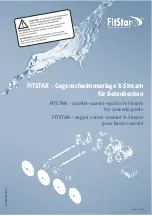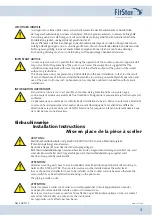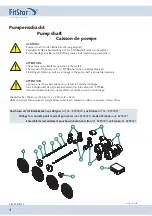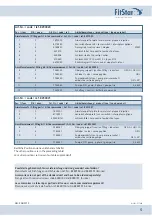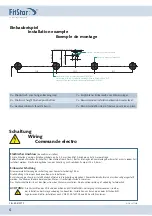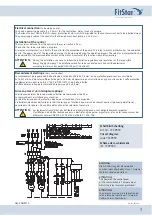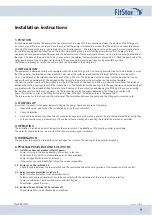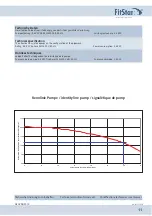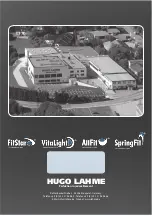
9
DXJR/DKPH*PE+
Art. Nr.: 577460
Stand 08/2010
1. POSITION
It is recommended to place the pump of the counter-current in a way that the connection between the pump and the fitting parts
is as short as possible. In any case you have to ensure that the pump is installed in a manner that the axle is in a horizontal position.
Changing the place of the pump is possible due to construction reasons. We recommend not to go beyond 5 m maximum distance
for avoiding any higher flow reduction on the suction side. While placing the installation please ensure that the pipes in that
maximum area are passed without breakes and in a horizontal way. If there are larger distances, you have to increase the diametre of
the pipes. The place of the pump has to be an area, where the ambient temperature does not exeed 40°C. Place the pump under the
water level because the pump does not suck itself. The pump and the locking parts have to be accessible any time.
Ventilation and drainage as well as floor drain have to be provided in the pump shaft.
2. INSTALLATION
The equipment is delivered serially with complete wall built-in and fitting parts. The housing pressure side has to be installed in a way
that the center of the injection nozzles is 200-250 mm under the water level and that the minimum distance to the side wall is
1.5 m. The distance of the injection nozzles to each other is 200 mm. The boreholes for the housings into the pool barrier can be
made without any problem with the included drilling template. Please follow the instructions on the drilling template.
The housing suction side should be installed in a way that the centre of the housing is 800 mm under the water level. The distance
between the suction housings to each other should be 2 m. The boreholes for the housings into the pool barrier can be made without
any problem with the included drilling template. After finishing of the construction and cleaning the fitting parts you can assembly
the injection nozzles and the suction sieves. Fix the suction sieves with the screws delivered at the fitting part suction side.
Screw the injection nozzles in the fitting parts pressure side. After that, install the air inlet in the pump shaft.
The return-valve has to be fixed over the water level. The connection between the pump and the fitting parts is made on site.
3. STARTING UP
Ensure that the pool is full of water before starting up the pump. Avoid any dry run of the pump.
1.
Open both valves and turn on the installation by using the sensor switch.
2.
Check air injection.
3.
Hose and tube connections have to be checked on leakage during the working process. Due to temperature differences tighting
of the connections can get neccessary. (Check the system on leakage by reducing the installation as much as possible).
4. OPERATING
The installation is switched on or off by pushing the sensor switch. The direction of the injection nozzles is adjustable.
The water jet should be set up in a way that the swimmer swims against whole jet.
5. HIBERNATION
The pump has to be empty. Close both valves and open the screw on the housing of the pump for emptying.
6. POSSIBLE PROBLEMS AND SOLUTIONS
6-1. Installation does not produce sufficient power:
Pump is turning in the wrong direction. Water level is too low.
Pump sucks in air. Valve is not completly open. Suction pipe leaks.
Pump is clogged (with leaves for instance).
If the causes can not be identified, inform the service responsible.
6-2. Pump can not be switched on:
Check the cable between the sensor switch and the control and check the configuration of the connection of the control.
6-3. Relay for motor protection switches off:
Relay for motor protection is not adjusted correctly.
Rated current and local situations have to be consistent with the adjustment of the relay for motor protection.
Pump is overheated. Cool down the motor and start it again.
Phase failed - check the fuses.
6-4. Residual Current Device (RCD) switches off:
The equipment has to be checked by an electrician.
Installation instructions

